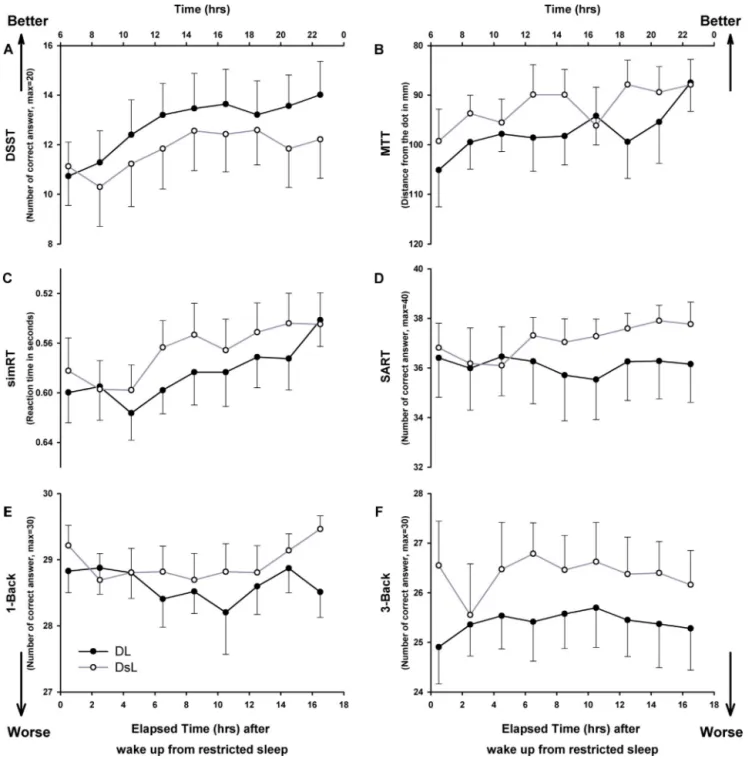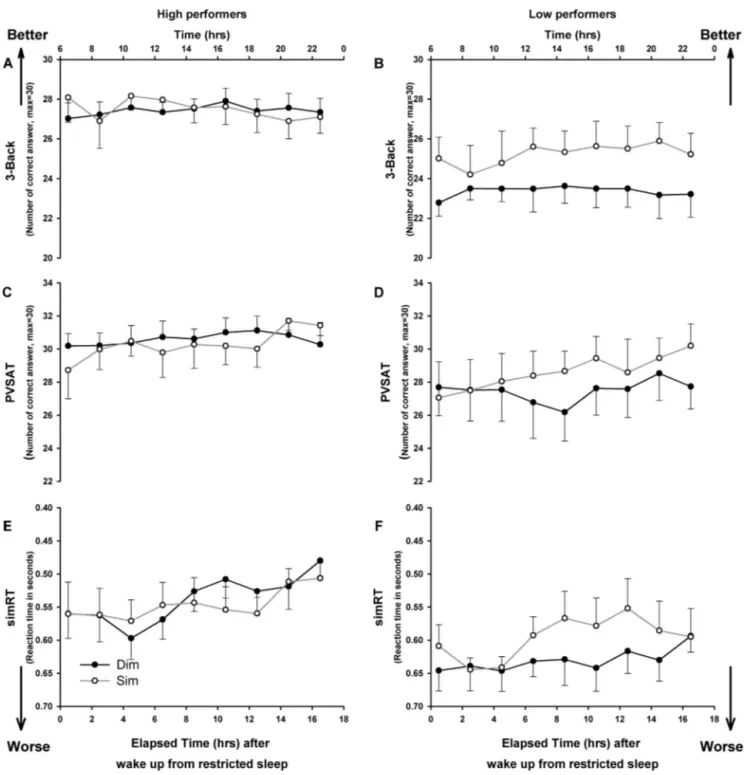ContentslistsavailableatScienceDirect
Behavioural
Brain
Research
j o ur na l h o me p a g e :w w w . e l s e v i e r . c o m / l o c a t e / b b r
Research
report
Dawn
simulation
light
impacts
on
different
cognitive
domains
under
sleep
restriction
Virginie
Gabel
a,∗,
Micheline
Maire
a,
Carolin
F.
Reichert
a,
Sarah
L.
Chellappa
a,b,
Christina
Schmidt
a,
Vanja
Hommes
c,
Christian
Cajochen
a,
Antoine
U.
Viola
aaCentreforChronobiology,PsychiatricHospitaloftheUniversityofBasel,4012Basel,Switzerland bCyclotronResearchCenter,UniversityofLiège,Liège,Belgium
cITVitaLightI&DPCDrachten,PhilipsConsumerLifestyle,theNetherlands
h
i
g
h
l
i
g
h
t
s
•Weinvestigatedmorninglighteffectsoncognitionafteranightofsleeprestriction.
•Morninglighteffectsdependoncognitivedomain.
•Morninglighteffectsdependonindividualperformancelevels.
a
r
t
i
c
l
e
i
n
f
o
Articlehistory:
Received21October2014 Receivedinrevisedform 15December2014 Accepted19December2014 Availableonline27December2014
Keywords:
Dawnsimulationlight Sleeprestriction Cognitiveperformance
a
b
s
t
r
a
c
t
Chronicsleeprestriction(SR)hasdeleteriouseffectsoncognitiveperformancethatcanbecounteracted
bylightexposure.However,itisstillunknownifnaturalisticlightsettings(dawnsimulatinglight)can
enhancedaytimecognitiveperformanceinasustainablematter.
Seventeenparticipantswereenrolledina24-hbalancedcross-overstudy,subsequenttoSR(6-hof
sleep).Twodifferentlightsettingswereadministeredeachmorning:a)dawnsimulatinglight(DsL;
polychromaticlightgraduallyincreasingfrom0to250lxduring30minbeforewake-uptime,withlight
around250lxfor20minafterwake-uptime)andb)controldimlight(DL;<8lx).Cognitivetestswere
performedevery2hduringscheduledwakefulnessandquestionnaireswerecompletedhourlytoassess
subjectivemood.
Theanalysesyieldedamaineffectof“lightcondition”forthemotortrackingtask,sustainedattention
toresponsetaskandaworkingmemorytask(visual1and3-backtask),aswellasfortheSimpleReaction
TimeTask,suchthatparticipantsshowedbettertaskperformancethroughoutthedayaftermorningDsL
exposurecomparedtoDL.Furthermore,lowperformersbenefitedmorefromthelighteffectscompared
tohighperformers.Conversely,nosignificantinfluencesfromtheDsLwerefoundforthePsychomotor
VigilanceTaskandacontraryeffectwasobservedforthedigitsymbolsubstitutiontest.Nolighteffects
wereobservedforsubjectiveperceptionofsleepiness,mentaleffort,concentrationandmotivation.
Ourdataindicatethatshortexposuretoartificialmorninglightmaysignificantlyenhancecognitive
performanceinadomain-specificmannerunderconditionsofmildSR.
©2014ElsevierB.V.Allrightsreserved.
Abbreviations: NIF,Non-ImageForming;fMRI,functionalMagneticResonance Imaging;SR,sleeprestriction;DsL,Dawnsimulationlight;DL,dimlight;MTT, MotorTrackingTask;DSST,DigitSymbolSubstitutionTest;PVSAT,PacedVisual SerialAdditionTask;simRT,SimpleReactionTimeTask;SART,SustainedAttention toResponseTask;PVT,PsychomotorVigilanceTask;V1-V2-V3,1,2,3-back:Visual N-backTask;SC,superiorcolliculus.
∗ Correspondingauthorat:PsychiatricHospitalofUniversityofBasel,Centrefor Chronobiology,WilhelmKlein-Strasse27,CH-4018Basel,Switzerland.
Tel.:+41613255908;fax:+33676211028. E-mailaddress:Virginie.gabel@upkbs.ch(V.Gabel).
1. Introduction
Numerousfactorscaninfluencecognitiveperformance,chief
amongthemaretheimpactoftimeofday[1,2]andhomeostatic
sleep pressure [3]. Chronic sleep restriction (SR) has
deleteri-ouseffects not onlyondaytimealertnessbut alsooncognitive
performance[4,5].
Indeed, sleepdisruptionresultsin specific cognitive
impair-ments including deficits in attention, executive function,
non-declarative and declarative memory, as well as emotional
reactivityandsensoryperception[6–8].Somestudiesshowthat
http://dx.doi.org/10.1016/j.bbr.2014.12.043
light exposure can act as countermeasure for these cognitive
impairmentsinhumans[9,10].
Theseacute impacts of light areusually referred toas
non-visual (or Non-Image Forming – NIF) effects, since they drift
apartfromclassicalinvolvementofrodandconephotopigments
in visual responses to light. NIF light effects at shorter
wave-length via novel photoreceptors containing the photopigment
melanopsinappeartostronglyimpactthehumancircadiantiming
system[11,12].Behaviouralresponsestriggeredbylight
encom-passimprovedalertnessandperformance,asindexedbyspecific
corticalresponsestocognitivetasksinPhotonEmission
Tomogra-phyandfunctionalMagneticResonanceImaging(fMRI)techniques
[13].However,dosage(intensityandduration),timingand
wave-lengthoflightfordomesticuseandintheworkplaceenvironments
aredifficulttodefineandmaycriticallydependonenvironmental
andtheindividualfactors.
Inapreviousstudy,wehaveshownthatexposuretogradually
increasinglightpriortoawakeningcancounteractsleep
restric-tioneffectsonwell-beingandcognitiveperformanceacrossthe
day,leadingtoanoptimizedlevelofalertness,whichimpingeson
enhancedperformanceonspecificcognitivetaskstightlyrelatedto
sustainedlevelsofattention[14].
Mostoftheeffectswerevisibleonthefirstdayafterthesleep
restrictionnightbutnotontheseconddayaftertwonightsofsleep
restriction,mostlikelyduetotheincreaseinsleeppressure.
Theoverallaimofthepresentstudywastoinvestigatewhether
dawnsimulationlightfollowingsleeprestriction,enhances
perfor-manceaccordingtocognitivedomainandwhethertheseeffectsare
sustainedduringtheentireday.
2. Materialandmethods
2.1. Studyparticipants
Studyvolunteerswererecruitedthroughadvertisementsat
dif-ferentlocaluniversitiesandwebsitesinSwitzerland,Germanyand
France.Screening procedurebegan witha telephoneinterview,
involvingadetailedstudyexplanation.Allparticipantsgavewritten
informedconsentbeforethestartofthelaboratorypart.Study
pro-tocol,screeningquestionnairesandconsentformswereapproved
bythelocalethicscommittee(EKBB/EthikkommissionbeiderBasel,
Switzerland)andconformedtotheDeclarationofHelsinki.
Allapplicantscompletedquestionnairesabouttheirsleep
qual-ity,lifehabitsandhealthstate.Thesequestionnairescompriseda
consentform,a generalmedicalquestionnaire,BeckDepression
InventoryII[15], EpworthSleepinessScale [16], Horne Ostberg
MorningnessEveningnessQuestionnaire[17],MunichChronotype
Questionnaire[18]and PittsburghSleepQualityIndex.Potential
candidateswitha PittsburghSleepQualityIndexscore>5were
excludedfromparticipation[19].Furtherexclusioncriteriawere
smoking,medicationordrugconsumption,bodymassindex<19
and>28,shiftworkandtransmeridianflightswithinthelastthree
months,aswellasmedicalandsleepdisorders.Sinceourstudy
pro-tocolincludedtwonightsofpartialsleeprestriction(restrictionto
6-h),wealsoexcludedparticipantswithhabitualsleepdurations
<7-hand>9-h[20],tominimizeapossibleconfoundingeffectsof
sleepduration.
Eighteenyoungmen(20–33yearsold;mean+StandardErrorof
Mean:23.1+.8)fulfillingallthecriteriawereenrolledinthestudy.
Acomprehensivetoxicologicalanalysisofurinefordrugabusewas
carriedoutbeforethestudy,alongwithanophthalmologic
exam-inationtoexcludevolunteerswithvisualimpairments.
Oneweekbeforethestudy,participantswerenotallowedto
drinkexcessivealcohol, and toconsumecaffeine orcacao
con-tainingdrinksormeals(atmost5alcoholicbeveragesperweek,
and 1cupof coffee or1caffeine-containing beverageperday).
Theywerealsoinstructedtokeeparegularsleep-wakeschedule
(bedandwaketimeswithin±30minofself-selectedtargettime).
Compliancetothisoutpatientsegmentofthestudywasverified
by wristactigraphy(actiwatchL, Cambridge Neurotechnologies,
Cambridge,UK)andself-reportedsleeplogs.
Thestudywascarriedoutduringthewinterseason(January
to March) in Basel, Switzerland, and comprised two segments,
distributedinabalancedcross-overdesign,separatedbyatleast
1-weekinterveningperiod.Thevolunteersreportedtothe
Cen-treforChronobiologyatthePsychiatricHospitaloftheUniversity
ofBaselontwooccasions(controlconditionandoneexperimental
conditions),wheretheystayedinindividualwindowlessbedrooms
withnoinformationabouttimeofday.Sincewedidnotfind
signif-icanteffectsoncognitiveperformanceneitherafterthebluelight
exposurenoraftertheDsLexposureafterthesecondnightofsleep
restriction,wedecidedtofocushereonthefirst24-hofthecontrol
conditionandtheDsLcondition.Themostlikelyexplanationwas
thatsleeppressurewastoohighafterthesecondnightofsleep
restriction, and thusthemorning lightcouldnot counteractits
Fig.1. (A)Protocoldesign.Twoarmsofa6-hsleeprestrictedprotocolwith dif-ferentmorninglightexposures.Elapsedtimeindicationisrelativetoanarrivalin thelabat8p.m.Time-of-dayindicationvariedacrossallsubjectsbutwasgiven inthefigureasanexample(takenfromthemeanofthesleep/waketimefromall participants).(B)Morninglightdevice.Spectralcomposition(lightwavelengthby irradiance(W/m2nm))oftheDawnSimulationLightat5min(greysolid),15min (greydash),24min(blacksolid)and30min(blackdash).
detrimentaleffect.Formoredetails,referredtoGabeletal.[14].
These24-hincludethefirstsleeprestrictionnight(6-h)at0lx
start-ingatthesubject’shabitualsleeptimeandfollowedby18-hof
datarecordingduringwakefulness.Duringtheday,inboth
condi-tions,participantswereexposedtodimlight(<8lx)during2-hafter
wake-upandto40lxfortheremainderofthedayuntiltheywent
tobed(Fig.1A).Inbothconditions,theinvestigatorenterstheroom
inthemorning,6-hafterlightoff,towake-uptheparticipants.
Thelight treatmentwasadministeredafterthesleep
restric-tionnighteitherwithnoadditionallightforthecontrolcondition
orwithaDawnSimulationLight(DsL:LEDprototypeofPhilips
Wake-upLightHF3520,PhilipsDrachten,TheNetherlands)
(poly-chromaticlightgraduallyincreasingfrom0to250lxduring30min
beforewake-uptime;thelightremainsaround250lxfor20min
afterwake-uptime),placed nearthebedateyes level(Fig.1B).
One participant could not be included in the analysis because
ofpoorqualityoftheelectroencephalogramrecordingsand
non-complianceduringcognitivetesting.Theremaining17volunteers
underwentbothlightconditionsinabalancedcross-overdesignas
follows:DL–DsLforninevolunteersandDsL–DLforeight.
2.2. Assessmentofsubjectiveratings
Subjectivesleepinesswasassessed everyhourwitha Visual
AnalogueScale(100mmscale).Likewise,aftereverytestsession
participanthadtoindicatetheeffort,concentrationandmotivation
theyneededtoperformthetests.A100mmeffortvisualanalogue
scalewasused,rangingfrom“0:little”to“100:much”[21,22].
2.3. Cognitiveperformance
Alltestswereadministeredevery2hduringwakefulness,
start-ing30minafterwakeup.ThetestbatterycomprisedtheMotor
TrackingTask(MTT),DigitSymbolSubstitutionTest(DSST)[23],
PacedVisualSerialAdditionTask(PVSAT)[24,25],Sustained
Atten-tionto ResponseTask(SART) [26],Psychomotor VigilanceTask
(PVT)[27],SimpleReactionTimeTask(simRT)andVisualN-back
Task(1,2,3-back)[28].For detailedinformation abouteach test,
pleaseseeTable1.
Alltheresultsaregivenrelativetoelapsedtimeafterwake-up
fromrestrictedsleeptakenat6a.m.Time-of-dayindicationwas
alsoaddedtobemoreinformativeandunderstandableforgeneral
public;itisanexamplecalculatedwiththemeanoftheparticipants
sleep/wakecycle,astheydidnothavethesamescheduledtime.
2.4. Statisticalanalysis
Forallanalyses,thestatisticalpackageSAS (version9.1;SAS
Institute,Cary,NC,USA)wasused.Statisticalanalyseswerecarried
outforeachvariable(subjectivefatigue,motivation,concentration,
effort,PVT,MTT,DSST,SimRT,SART,PVSATandN-Back)separately
withthemixed-modelanalysisofvarianceforrepeatedmeasures
Table1
Descriptionofthetasksinthecognitivetestbattery.
Tests Cognitivedomain Explanationofthetests References
MotorTrackingTask(MTT) Peopleneedtotrackacomputer-generateddiscusingthe mouse,alonganothercomputer-generatedpointfor20s DigitSymbolSubstitution
Test(DSST)
Computer-based“cognitive throughput”task(orattention-based task)measuringclericalspeedand accuracy.Thetaskbecomesless sensitivetochangesinattentionand moresensitivetomemoryimpairment.
Participantsarerequiredtoselectapredefineddigitin responsetoeachappearanceofanabstractsymbol(thekey linkingsymbolsanddigitsareavailableonscreenthroughout testing).Theylearnthecodingrelationshipsaftersome experience.Inthispacedversionofthetask,8symbolsare presentedfor500ms,withanISIof1500ms.Eachsymbol occuranequalnumberoftimes.
Asteretal.[23]
PacedVisualSerial AdditionTask(PVSAT)
Additiontaskheavilydependenton frontalbrainregions,involving executiveaspectsofworkingmemory
Singledigits(1to9)appearonscreenandeachmustbeadded tothedigitwhichprecededit,andtheresultingansweris selectedfromanon-screennumericalkeypad(“sum”of adjacentpairs,notatotalacrossalldigitspresented).Digits wereseenfor1000ms,withinter-stimulusinterval(ISI)of 2000msinbetween.
Feinsteinetal.[24]; Nagelsetal.[25]
SustainedAttentionto ResponseTask(SART)
Sustained/dividedattentiontaskin whichinattentionandinhibitory processingcanbemeasured separately.Bothtypesofperformance dependonthefrontalcortex
It’sacomputer-basedtask,usedhereasaGo/NoGotask,which requiresparticipantstomonitorsingledigitspresentedrapidly onscreen,andrespondtoeachonethatappears(calledGo target),exceptforaparticularpre-defineddigit(calledNoGo target).Digitsarepresentedfor1000ms,withaninter-item intervalof2000ms,with15“targets”(whereresponsesare withheld)randomlyinterspersedwith25distractors.
Robertsonetal.
[26]
Psychomotorvigilancetask (PVT)
Sustainedattentiontask,sensitiveto circadianvariationandsleeplossItis anapproachofDinges(Dinges,Pack etal.,1997).
ThePVTinvolvesa5-minvisualreactiontime(RT) performancetestinwhichthesubjectisrequiredtomaintain thefastestpossibleRT’stoasimpleauditorystimulus.Data analysesfocusonRT,errors,andsignaldetectiontheory parameters.
Dingesetal.[27]
SimpleReactionTimeTask (simRT)
Indicatorofspeededmotor performance.
Varyasafunctionofalertnessand sleepdeprivation
Thistaskrequirespeopletorespond,asquicklyaspossible,toa single,predictablestimulus.Theparticipantrestshis/herindex fingeronamouse,andhavingdonesooverthenext1000msa wordsuchas“Now!”appears,atwhichpointtheparticipant movesthecursortoadesignatedtargetposition.Thetime takenfromNow!Totheonsettomovethecursorfromthe restingpositionreflectstheparticipants’abilitytodetectthata responseisrequired,and,togetherwiththesubsequenttime takentomovethemousetothetargetposition,giveustheRT. VisualN-backTask
(1,2,3-back)
Executiveaspectsofworkingmemory Stimuliarepresentedindividuallyonacomputerscreen,and theparticipantmustindicate(usingthemouse),ifthecurrent stimulusandthenstimulipriortoitmatch.Thehigherthen, thestrongerarethedemandsofexecutivefunctioning.Stimuli arepresentedfor500mswithanISIof1500ms.Theratio betweenmatchtonon-matchtrialsisof1:2with30items.
Table2
Resultsoftheanalysisofthevariancefordifferentvariablesofsubjectivefeelingforthetimecourseofthestudy. Variable Analysisofthevariance
Light Timeofday Light×Time
Effort F1,254=0.14,p=.7059 F8,254=1.21,p=.2927 F8,254=51,p=.8485
Concentration F1,254=.69,p=.4061 F8,254=1.42,p=.1877 F8,254=1.08,p=.3806
Motivation F1,254=2.87,p=.0913 F8,254=1.56,p=.1377 F8,254=.45,p=.8927
Fatigue F1,254=00,p=.9996 F8,254=4.28,p<.0001 F8,254=1.07,p=.3830
(PROCMIXED),withwithinfactors“lightcondition”(dimlight[DL]
versusdawnsimulationlight[DsL])and“time-of-day”(allassessed
timepoints).
Afurtheranalysisincludedthefactor“group”wasdone,
accord-ingtothesubject’sperformanceonthe3-backtask.Asthisworking
memoryparadigmpresentsarelativelyhighcognitiveloaditmight
besuitabletodifferbetweenhighandlowperformers.Thus,we
performedamediansplitandconsideredsubjectspresenting
per-formancesbelowthemedianoftheoverallgroupaslowperformers
(N=9)andthoseaboveashighperformers(N=8).
3. Results
3.1. Assessmentofsubjectiveratings
Nosignificantdifferenceswerefoundbetweenlightconditions
for effort,concentration andmotivation neededtoperformthe
tasks.Similarly,subjectivesleepinessinducedbythetestdidnot
differacrossthelightconditions(Table2).Fordetailedinformation
onsleepiness,well-beingandmood,pleasesee[14].
3.2. Cognitiveperformance
3.2.1. MTT
Main effects of “light condition” and “time-of-day” were
observedfortheMTT(Table3),suchthataftertheDsLexposure
par-ticipantswerebetteratfollowingthedotthanaftertheDLexposure
duringtheentireday(Fig2B).
3.2.2. DSST
Maineffectsof“lightcondition”and“time-of-day”werealso
observedforDSST(Table3)butintheoppositedirection.
Partic-ipantsperformedbetteraftertheDLexposurethanaftertheDsL
exposurethroughouttheday(Fig.2A).
3.2.3. PVSAT
PVSATperformancedidnotyieldsignificantdifferencesneither
forthemainfactors“lightcondition”,norfortheinteractionof
“lightcondition×time of day” (Table 3). Only thefactor “time
of day” was significant such that participants improved their
performanceacrossthedayindependentoflighttreatment(data
notshowninthefigure).
3.2.4. SART
Maineffectof“lightcondition”(Table3)wasobservedfor
accu-racy(correctanswersforGoandNoGotargets),suchthatuntil5-h
oftimeawake,theperformancewasnotsignificantlydifferent
irre-spectiveoflightsettings,while6-hafterwake-timeDsLimproved
performancealongthedayascomparedtoDL(Fig.2D).
Besides,NoGotrials wereanalyzed asa proxyfor inhibition
control.Itrevealedamaineffectof“lightcondition”(p=0.0013).
ParticipantshadlesscorrectNoGoanswersaftertheDsLexposure
thanaftertheDLexposureandmostlyatthebeginningoftheday.
Furthermore,themissedanswers(missedGoanswers)showeda
maineffectof“lightcondition”(p<0.0001),suchthattheDsLled
tolowerlevelsofmissedanswersthantheDL.Thereactiontime
forthistaskshowedalsoasignificanttrendofthe“light
condi-tion”effect(p=0.0876),suchthatparticipantsansweredfasterat
thebeginningofthedayaftertheDsL.
3.2.5. PVT/simRT
TheDsLexposuredidnotinfluencereactiontimeduringthePVT
(Table3,datanotshowninthefigure)andperformancewassimilar
afterbothlightexposures.However,theDsLdecreasedreaction
timeintheSimRTtestthroughouttheday,asshownbyamain
effectof“lightcondition”and“timeofday”(Table3,Fig.2C).
3.2.6. N-BACK
The1-Backshowedamaineffectof“lightcondition”(Table3)for
accuracy,drivenbyDsLexposure.After4-hofelapsedtimeawake,
DsLimprovedaccuracy,withastrongereffectintheevening,while
performanceremainedstableafterDLexposure(Fig.2E).
Nosignificantdifferenceswerefoundbetweenbothlight
con-ditionsinthe2-Backtest(datanotshowninthefigure).
Forthe3-Backtest,wefoundamaineffectof“lightcondition”,
suchthatparticipantshadahigherrateofcorrectanswersaftera
DsLthanafteraDLexposure,startingatthebeginningoftheday
andremainingalltheday(Fig.2F).
Table3
Resultsoftheanalysisofthevariancefordifferentvariablesofcognitiveperformanceforthetimecourseofthestudy. Variable Analysisofvariance
Light Timeofday Light×Time
MTT F1,260=1.76,p=.0079 F8,260=2.05,p=.0407 F8,260=.58,p=.7933 DSST F1,254=7.22,p=.0077 F8,254=2.44,p=.0148 F8,254=.25,p=.9800 SimRT F1,271=5.52,p=.0195 F8,271=3.07,p=.0025 F8,271=.33,p=.9554 PVT F1,264=3.31,p=.0700 F8,264=1.95,p=.0528 F8,264=.44,p=.8933 SART F1,255=5.07,p=.0252 F8,255=.28,p=.9731 F8,255=.31,p=.9601 PVSAT F1,272=0.96,p=.3277 F8,272=2.42,p=.0152 F8,272=.90,p=.5204 1-Back F1,255=5.86,p=.0162 F8,255=.66,p=.7269 F8,255=.88,p=.5368 2-Back F1,255=0.04,p=.8323 F8,255=.56,p=.8127 F8,255=1.12,p=.3497 3-Back F1,254=16.69,p<.0001 F8,254=.48,p=.8716 F8,254=.16,p=.9952
MTT:MotorTrackingTask;DSST:DigitSymbolSubstitutionTest;SimRT:SimpleReactionTimeTask;PVT:PsychomotorVigilanceTask;SART:SustainedAttentiontoResponse Task;PVSAT:PacedVisualSerialAdditionTask;1-2-3-Back:VisualN-backTask.
Fig.2.Accuracyofthecognitiveperformanceovertheday.
Timecourseofthe(A)DigitSymbolSubstitutionTest(DSST),the(B)MotorTrackingTask(MTT),the(C)SimpleReactionTimeTask(simRT),the(D)SustainedAttentionto ResponseTask(SART),the(E)Visual1-backTask(1-Back)andthe(F)Visual3-backTask(3-Back)in17participantsunderDimlight(blacklines)orDawnSimulationLight (greylineswithblackcircle).Dataareplottedasameanforeach2-hbinrelativetoelapsedtime(h)afterwake-upfromrestrictedsleep,andtheerrorbarsrepresentthe standarderrorofthemean.Elapsedtimeindicationisrelativeto6a.m.wake-uptime.
3.2.7. Reactiontimes
Furthermore,thecomposite score ofthe reactiontime from
those cognitive tests presenting higher cognitive load (n-Back,
SART,PVSAT)wassignificantlyloweraftertheDsLthanafterthe
DL(supplementarydata).
3.3. Highvs.lowperformers
Splittingthegroupaccordingtohighandlowperformance,a
maineffectof“lightcondition”waspresentinthelowbutnotin
thehighperformers,suchthattheDsLlightimprovedperformance
inthePVSAT(p=0.0096),the3-Backtest(p<0.0001)andthesimRT
test(p=0.0064)comparedtotheDLcondition(Fig.3).
4. Discussion
Ourdatashowthatartificialmorninglightexposure,asindexed
byDsL,hasatask-dependenteffectoncognitiveperformanceunder
sleeprestrictionconditions,suchthatmorningDsLsignificantly
enhancedperformanceonattention-basedtasks(SART,1-verbal
Back,and simRT).Furthermore,DsLsignificantlyimproved
per-formanceontheMTT that involvesmotor-basedskills, andthe
Fig.3. Accuracyofthecognitiveperformanceoverthedayinthehighandlowperformers.
Timecourseofthehighperformers(leftpanel)andthelowperformers(rightpanel)ofthe(A)Visual3-Back(3-Back),the(B)thePacedVisualSerialAdditionTask(PVSAT) andthe(3)SimpleReactionTimeTask(simRT)in17participantsunderDimlight(blacklines)orDawnSimulationLight(greylineswithblackcircle).Dataareplottedasa meanforeach2-hbinrelativetoelapsedtime(h)afterwake-upfromrestrictedsleep,andtheerrorbarsrepresentthestandarderrorofthemean.Elapsedtimeindication isrelativeto6a.m.wake-uptime.
wealsofoundbetterperformanceaftertheDLcomparedtotheDsL
fortheDSST.
Our results corroborate our previous analysis that artificial
morning dawn simulation light improvessubjective perception
ofwell-beingandmood,aswellascognitiveperformanceacross
thedayunderconditionsofmildsleeprestriction[14].However,
hereweshowedthatthelighteffectonperformancedependson
theinvestigatedcognitivedomain,suggestingthatdifferent
path-waysmaybeimplicatedinthiseffect.Previousstudiesindicatethat
eveninglightexposureimpactsonnumerousdomainsofcognitive
performancesuchassustainedattention[10],workingmemory
andattention,aswellasdeclarativememory[9].
Hereweshowthatlightexposureduringthemorninghours
cansignificantlyboostcognitiveperformanceandmaintainits
sta-bilitythroughouttheday.Moststudiesontheeffectsoflightin
humans have been carried out during the night, when light is
abletocounteracttheincreasingsleeppressure,andthus
signif-icantlyenhanceorstabilizecognitiveperformance(forareview,
see[29]).Inthiscontext,themodulatorymechanismsaccounting
forthelighteffectsoncognitionhavebeenascribedtoitsimpacton
sleephomeostasisand/oritsindirectsynchronizing/phase-shifting
effectsonthecircadiantimingsystem[10].However,alternative
mechanismsmaybypassthesesystems,thuselicitingdirect
Evidenceforthelatterarisesfromstudiesinwhichdaytime
per-formanceincreasedafter30minfromlightonset[30,31],froman
fMRIstudyinwhichdaytimelightenhancedcognitivebrainactivity
duringanoddballtask[32]andfromourpreviousanalysisinwhich
morninglightexposure(dawnsimulationlight)increased
well-beingandenhancedperformancesacrosstheday[14].Recently,
anotherstudyshowedthecriticalroleoflightforcognitivebrain
responses in emphasizing the evidence of a cognitive role for
melanopsin, which may confer a form of “photic memory” to
humancognitivebrainfunction[33].Collectively,thesedata
sug-gestthatlightmaymodulateongoingcorticalactivityinvolvedin
alertness,thusstimulatingcognitivebrainfunction.
Onecrucialbrainregioninvolvedintheimpactoflighton
cog-nitionistheanteriorhypothalamus,inlocationscompatiblewith
thesuprachiasmaticnucleusandtheventrolateralpreopticnucleus
[34].Thisregionispostulatedtobetheprimarylinkoftheretina
tothebrain,thusmediatingtheeffectoflightoncognition[13].
Furthermore,numerous retinalprojections extendtothelateral
geniculatenucleusandalso(albeitless)tothesuperiorcolliculus
(SC).Fromthelateralgeniculatenucleus,projectionsaresentto
theprimaryvisualcortex,whichisthefirstprocessingsiteofthe
corticalvisualpathway.Functionally,thispathwayisclassifiedin
dorsalandventralstreams[35].Theformerisassociatedtomotion
processing(medialtemporalandsuperiortemporal,andalso
pari-etalcortices),while thelatterinvolvessalientvisualprocessing
[36].Interestingly,attention-relatedmodulatoryeffectsimpacton
bothstreams.Withinthedorsalstream,attentionis“encoded”by
neuronsinvolvedinspatialattention/feature-basedattention,such
astheorientationofanobjectoramovingdot[36].Concomitantly,
motion-sensitivemedialtemporalandsuperiortemporalareasare
alsoinvolvedintheseprocesses,aswellashighercorticalareas
suchastheintraparietalcortex[37].Wetentativelyspeculatethat
thisparticularnetworkmaybeunderlyingtheresponsesinthe
MTTtask,andthatlightmightplayamodulatoryroleonthistype
ofspatialattention/feature-basedattention.
Withrespecttotheventralattention-basedstream,akey
struc-tureinvolvedinthisattentionalnetworkistheSC,whichreceives
directinputfromtheretina.Thisattentionnetworkispresumably
sharedwiththeintraparietalregion[38],frontaleyefields[39],and
visualcortices,throughdirectconnectionsfromthecortextothe
SC,andindirectlyfromtheSCtothecortexviathepulvinar[40].The
pulvinar(dorsalthalamicnuclei)ispivotalinattentionmodulation,
presumablythroughtheflowofinformationinthebrain.Itreceives
adirectretinalprojection,andprovidesanindirectlinkbetween
thesuprachiasmaticnucleusandtheprefrontalcortex[41].Thus,
itmediatesarousalregulation,andaneffectoflightonthe
thala-muswillprobablyresultinawidespreadcorticalimpact,suchason
attention-basedcognitiveperformance.Takentogether,we
postu-latethatthesebrainnetworksmayunderliethemodulatorylight
effectsonnumerousdimensionsofattentiontasks,suchasonMTT,
1-Back,simRTandSART.Itcouldalsoexplainthelackofcorrect
NoGoanswersandthedecreaseofthemissedGoanswersinthe
SARTtestaftertheDsLexposure.Effectively,arousallevelsaremore
prominentatthebeginningofthedayandmightevenbemore
pro-nouncedafteralightexposure,whichexplainsresponseaccuracyat
thebeginningoftheday.However,differenttasksrequiredifferent
levelsofarousalforoptimalperformance[42].Forexample,
dif-ficultorintellectuallydemandingtasksmayrequirealowerlevel
ofarousal(tofacilitateconcentration),whereastasksdemanding
staminaorpersistencemaybeperformedbetterwithhigherlevels
ofarousal(toincreasemotivation)[43].Accordingtothisconcept,
itcouldbearguedthatthearousallevelaftertheDsLexposure
wastoohightoinhibittheparticipant’sanswersintheSARTtask,
whichisinaccordancewiththeincreaseofthereactiontimein
thistaskduringthefirsthoursafterwaketime.Thisleadstoa
speed-accuracytrade-offintheinhibitoryprocess,meaningthat
lightexposureinduceshigherexcitabilityresultinginfaster
reac-tiontimeandthusinlackofinhibitioncontrol.
OurPVTdatadidnotparallelearlierfindingsofabeneficiallight
effect[10,30].Onepossibilityisthat,contrarytoourdesign,these
studieschallengedsustainedattentionperformanceeitherduring
lightexposureanddidnotspecificallyexplorecarry-overeffectsor
afteraprolongeddaytimelightexposure.Howevertheyare
com-parabletothefindingsfromVandeWerken[44],showingthatthe
reactiontimesunderDsLweresimilartotheoneundercontrol
condition.OnecouldarguethatthePVTneedsahigherand,more
probably,asustainedlevelofarousalthantheSARTtest–which
isnotreachedhere–togettooptimalperformancelevels,since
thistaskismuchmoremonotonouswithmuchfewerstimuli(e.g.,
[45]).Theabsenceofasignificanteffectcouldbetracedbackto
thefactthatwecomparedreactiontimesafteronenightofsleep
restrictionbetweentwolightconditions.Thisisdifferenttoother
studies,comparingrestedwakefulnesstosleepdeprivedorsleep
restrictedconditions.Similarly,theDSSTshowedthecontraryof
theexpectedeffect,suchthatparticipantswereslowerinreacting
andlessaccurate.Wehavenostraightforwardexplanationforthe
opposingeffectoftheDSST.Itcannotbeduetoasimple
learn-ingeffectacrossconditionsaswecounterbalancedtheorderand
wedidnotdetectasignificantinteractionbetweentimeofdayand
condition.Neithertheobservedpatterncanbeattributedtogeneral
impairmentsinworkingmemoryfunctionsacrossthedayunder
DsLaswefoundbetterperformanceunderDsLforthen-Backtest.
Thesetwotaskswerethefirsttwotasksadministeredwithineach
testingsessions,thus,acertaintime-on-taskeffectcanberuledout,
andaflooreffectoflightimpactbecauseofhighdemandisequally
implausible.
Interestingly,ourdataalsoshowasignificantDsLeffectonthe
3-verbalbacktask.Thistaskchallengesworkingmemory,which
referstotheindividualcapacitytotemporarilymaintainactive
rel-evantinformationtoperformanongoingtask[46,47].Thistask
involvestheneedtocontinuouslyupdateandinhibitinformation,
andalsohasanattentionalcomponenttoit.Thus,onepossible
explanationtotheDsLeffects isthatlightmayenhance
perfor-manceonthe3-backtaskviaitsimpactonthebasicattention
componentinthiscomplexworking-memorytask.However,atthe
behaviourallevel,itisnotpossibletodissectoutthecomponents
existingwithinthistask.Thus,lightmightalsoimpactonthe
exec-utivecomponent ofthis task.The3-backtaskprobesexecutive
control,anditscerebralcorrelatesinvolvethebilateralposterior
parietalcortex,premotorcortex,dorsalcingulate/medialpremotor
cortex,dorsolateralprefrontalcortexandventrolateralprefrontal
cortex[48].Lightmayhaveamodulatoryeffectontheseanatomical
structures,thusimpactingonexecutivebrainresponses[49].
Furthermore,lighthasgreaterbeneficialeffectsonthelow
per-formers(stratifiedaccordingtothe3-Backresults)comparedto
thehighperformersinthe3-back,PVSATandsimRT.However,itis
importanttoconsiderapotentialceilingeffectforthehigh
perform-ers;asthesleeprestrictionwasnotthatsevere,theseparticipants
couldeasilycopewiththisandthus,keeptheirhighlevelof
per-formance.Thereby,theimpactoflightmighthavebeendifficultto
detect.
Interestingly,thelowperformersonthe3-backwhoprofitmost
fromthelightintervention arealsotheoneswho experiencea
detrimentaleffectoflightontheirreactiontimesinthePVT.This
issomewhatcontra-intuitive,aswepreviouslyshowedthatlight
leadstofasterreactiontime[10].However,itcouldindicatethatthe
lowperformersaremorecautiousintheirtaskperformanceunder
theeffectoflight,andthereforeprofitinacomplextask,where
accuracyisimportant,butdeclineinamorebasictaskwherefast
reactionsarerequired.Clearly,itindicatesthatthelighteffectis
dependentonthecognitivedomainandobviouslyalsoacts
5. Conclusion
Ourresultscollectivelyindicatethatshortexposuretogradually
increasingmorninglight(DsL)justbeforetheendofthepartially
restrictednightepisode,maysignificantlyenhanceperformance,
particularlyincognitivetasksassociatedtoattention.Inabroader
context,thesefindingspointtostrategiesthatmaydirectly
opti-mizeattention-relatedcognitioninreal-lifesettings,particularly
whenindividualsaresleeprestricted.
Supplementarydata
Reactiontimefromthecognitivetestsovertheday.Timecourse
ofthecompositeofreactiontimeofthePacedVisualSerial
Addi-tionTask(PVSAT),SustainedAttentiontoResponseTask(SART)
andVisual1-2-3-backTask(1-2-3-Back)in17participantsunder
Dimlight(blacklines)orDawnSimulationLight(greylineswith
blackcircle).Dataareplottedasameanforeach2-hbinrelative
toelapsedtime(h)afterwake-upfromrestrictedsleep,andthe
errorbarsrepresentthestandarderrorofthemean.Elapsedtime
indicationisrelativeto6a.m.wake-uptime.
Conflictsofinterest
Theauthorsreportnoconflictsofinterest.Theauthorsaloneare
responsibleforthecontentandwritingofthepaper.
Acknowledgments
We thank Dr. Götz for medical screenings, Claudia Renz,
Marie-France Dattler and Giovanni Balestrierifor their help in
data acquisition, AmandineValomon for her help in recruiting
volunteers and, of course,the volunteers to participating. This
researchwassupportedbyPhilipsConsumerLifestyle,Drachten,
TheNetherlands.
AppendixA. Supplementarydata
Supplementarydataassociatedwiththisarticlecanbefound,in
theonlineversion,athttp://dx.doi.org/10.1016/j.bbr.2014.12.043.
References
[1]DijkDJ,DuffyJF,CzeislerCA.Circadianandsleep/wakedependentaspectsof subjectivealertnessandcognitiveperformance.JSleepRes1992;1:112–7.
[2]SilvaEJ,WangW,RondaJM,WyattJK,DuffyJF.Circadianandwake-dependent influencesonsubjectivesleepiness,cognitivethroughput,andreactiontime performanceinolderandyoungadults.Sleep2010;33:481–90.
[3]BonnetMH.Performanceandsleepinessasafunctionoffrequencyand place-mentofsleepdisruption.Psychophysiology1986;23:263–71.
[4]VanDongenHP,MaislinG,MullingtonJM,DingesDF.Thecumulativecostof additionalwakefulness:dose-responseeffectsonneurobehavioralfunctions andsleepphysiologyfromchronicsleeprestrictionandtotalsleepdeprivation. Sleep2003;26:117–26.
[5]BelenkyG,WesenstenNJ,ThorneDR,ThomasML,SingHC,RedmondDP, etal.Patternsofperformancedegradationandrestorationduringsleep restric-tion and subsequent recovery: asleep dose-response study.J SleepRes 2003;12:1–12.
[6]DurmerJS,DingesDF.Neurocognitiveconsequencesofsleepdeprivation. SeminNeurol2005;25:117–29.
[7]JonesK,HarrisonY.Frontallobefunction,sleeplossandfragmentedsleep. SleepMedRev2001;5:463–75.
[8]Walker MP.Sleep-dependentmemoryprocessing. HarvardRevPsychiatry 2008;16:287–98.
[9]CajochenC,FreyS,AndersD,SpatiJ,BuesM,ProssA,etal.Evening expo-suretoalight-emittingdiodes(LED)-backlitcomputerscreenaffectscircadian physiologyandcognitiveperformance.JApplPhysiol2011;110:1432–8.
[10]ChellappaSL,SteinerR,BlattnerP,OelhafenP,GotzT,CajochenC.Non-visual effectsoflightonmelatonin,alertnessandcognitiveperformance:can blue-enrichedlightkeepusalert?PLoSOne2011;6:e16429.
[11]BersonDM,DunnFA,TakaoM.Phototransductionbyretinalganglioncellsthat setthecircadianclock.Science2002;295:1070–3.
[12]SmithMR,RevellVL,EastmanCI.Phaseadvancingthehumancircadianclock withblue-enrichedpolychromaticlight.SleepMed2009;10:287–94.
[13]VandewalleG,MaquetP,DijkDJ.Lightasamodulatorofcognitivebrain func-tion.TrendsCognSci2009;13:429–38.
[14]GabelV,MaireM,ReichertCF,ChellappaSL,SchmidtC,HommesV,etal.Effects ofartificialdawnandmorningbluelightondaytimecognitiveperformance, well-being,cortisolandmelatoninlevels.ChronobiolInt2013;30:988–97.
[15]BeckAT,WardCH,MendelsonM,MockJ,ErbaughJ.Aninventoryformeasuring depression.ArchGenPsychiatry1961;4:561–71.
[16]JohnsMW.Anewmethodformeasuringdaytimesleepiness:theEpworth sleepinessscale.Sleep1991;14:540–5.
[17]Horne JA, Ostberg O. A self-assessment questionnaire to determine morningness-eveningness in human circadian rhythms. Int J Chronobiol 1976;4:97–110.
[18]RoennebergT,Wirz-JusticeA,MerrowM.Lifebetweenclocks:dailytemporal patternsofhumanchronotypes.JBiolRhythms2003;18:80–90.
[19]BuysseDJ,Reynolds3rdCF,MonkTH,BermanSR,KupferDJ.ThePittsburgh SleepQualityIndex:anewinstrumentforpsychiatricpracticeandresearch. PsychiatryRes1989;28:193–213.
[20]AeschbachD,CajochenC,LandoltH,BorbelyAA.Homeostaticsleepregulation inhabitualshortsleepersandlongsleepers.AmJPhysiol1996;270:R41–53.
[21]VerweyW,VeltmanH.Detectingshortperiodsofelevatedworkload: com-parison of nine assessment techniques. J Appl Psychol Applied 1996;3: 270–85.
[22]DunhamKJ,ShadiS,SofkoCA,DenneyRL,CallowayJ.Comparisonofthe repeatablebatteryfortheassessmentofneuropsychologicalstatuseffortscale andeffortindexina dementiasample.Arch ClinNeuropsychol 2014;29: 633–41.
[23]AsterMvNA,HornRWAIS-III.WechslerAdultIntelligenceScaleFrankfurt/M., Germany:Harcourt2006.
[24]FeinsteinA,BrownR,RonM.Effectsofpracticeofserialtestsofattentionin healthysubjects.JClinExpNeuropsychol1994;16:436–47.
[25]NagelsG,GeentjensL,KosD,VleugelsL,D’HoogheMB,VanAschP,etal. Pacedvisualserialadditiontestinmultiplesclerosis.ClinNeurolNeurosurg 2005;107:218–22.
[26]RobertsonIH,ManlyT,AndradeJ,BaddeleyBT,YiendJ.‘Oops!’:performance correlatesofeverydayattentionalfailuresintraumaticbraininjuredand nor-malsubjects.Neuropsychologia1997;35:747–58.
[27]DingesDF,PackF,WilliamsK,GillenKA,PowellJW,OttGE,etal. Cumula-tivesleepiness,mooddisturbance,andpsychomotorvigilanceperformance decrementsduringaweekofsleeprestrictedto4-5hourspernight.Sleep 1997;20:267–77.
[28]CohenJD,PerlsteinWM,BraverTS,NystromLE,NollDC,JonidesJ,etal. Tem-poraldynamicsofbrainactivationduringaworkingmemorytask.Nature 1997;386:604–8.
[29]ChellappaSL,GordijnMC,CajochenC.Canlightmakeusbright?Effectsoflight oncognitionandsleep.ProgBrainRes2011;190:119–33.
[30]Phipps-NelsonJ,RedmanJR,DijkDJ,RajaratnamSM.Daytimeexposureto brightlight,ascomparedtodimlight,decreasessleepinessandimproves psy-chomotorvigilanceperformance.Sleep2003;26:695–700.
[31]RugerM,GordijnMC,BeersmaDG,deVriesB,DaanS.Time-of-day-dependent effectsofbrightlightexposureonhumanpsychophysiology:comparisonof daytimeandnighttimeexposure.AmJPhysiolRegulIntegrCompPhysiol 2006;290:R1413–20.
[32]VandewalleG,BalteauE,PhillipsC,DegueldreC,MoreauV,SterpenichV, etal.Daytimelightexposuredynamicallyenhancesbrainresponses.CurrBiol 2006;16:1616–21.
[33]ChellappaSL,LyJQ,MeyerC,BalteauE,DegueldreC,LuxenA,etal.Photic memoryforexecutivebrainresponses.ProcNatlAcadSciUSA2014;111: 6087–91.
[34]PerrinF,PeigneuxP,FuchsS,VerhaegheS,LaureysS,MiddletonB,etal. Nonvi-sualresponsestolightexposureinthehumanbrainduringthecircadiannight. CurrBiol2004;14:1842–6.
[35]GoodaleMA,MilnerAD.Separatevisualpathwaysforperceptionandaction. TrendsNeurosci1992;15:20–5.
[36]Baluch F, Itti L. Mechanisms of top-down attention. Trends Neurosci 2011;34:210–24.
[37]Martinez-TrujilloJC, TreueS.Feature-basedattentionincreases the selec-tivityofpopulationresponsesinprimatevisualcortex.CurrBiol2004;14: 744–51.
[38]BisleyJW,GoldbergME.Attention,intention,andpriorityintheparietallobe. AnnuRevNeurosci2010;33:1–21.
[39]ThompsonKG,BichotNP.Avisualsaliencemapintheprimatefrontaleyefield. ProgBrainRes2005;147:251–62.
[40]ShippS.Thefunctionallogicofcortico-pulvinarconnections.PhilosTransRoy SocLondonSerB:BiolSci2003;358:1605–24.
[41]SylvesterCM,KroutKE,LoewyAD.Suprachiasmaticnucleusprojectiontothe medialprefrontalcortex:aviraltransneuronaltracingstudy.Neuroscience 2002;114:1071–80.
[42]YerkesR,DodsonJ.Therelationofstrengthofstimulustorapidityof habit-formation.JComparatNeurolPsychol1908;18:459–82.
[43]Broadhurst PL. Emotionality and the Yerkes-Dodson law. J Exp Psychol 1957;54:345–52.
[44]VanDeWerkenM,GimenezMC,DeVriesB,BeersmaDG,VanSomerenEJ, GordijnMC.Effectsofartificialdawnonsleepinertia,skintemperature,and theawakeningcortisolresponse.JSleepRes2010;19:425–35.
[45]LimJ,DingesDF.Sleepdeprivationandvigilantattention.AnnNYAcadSci 2008;1129:305–22.
[46]BaddeleyA.Theconceptofworkingmemory:aviewofitscurrentstateand probablefuturedevelopment.Cognition1981;10:17–23.
[47]SchmidtC,ColletteF,CajochenC,PeigneuxP.Atimetothink:circadianrhythms inhumancognition.CognNeuropsychol2007;24:755–89.
[48]Sala-LlonchR,Arenaza-UrquijoEM,Valls-PedretC,Vidal-PineiroD,BargalloN, JunqueC,etal.Dynamicfunctionalreorganizationsandrelationshipwith work-ingmemoryperformanceinhealthyaging.FrontHumNeurosci2012;6:152.
[49]Vandewalle G,GaisS,Schabus M,Balteau E,CarrierJ, DarsaudA,et al. Wavelength-dependentmodulationofbrainresponsestoaworkingmemory taskbydaytimelightexposure.CerebCortex2007;17:2788–95.

